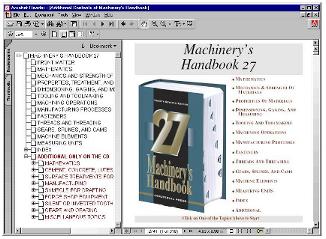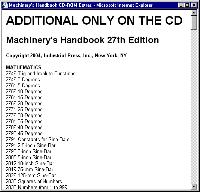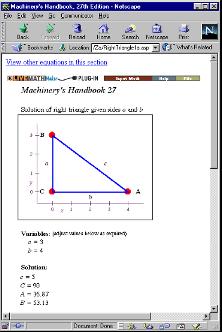|
REVIEW
by Jock Dempsey
Machinery's Handbook has always been one of my favorite references.
For details of the print version see our reviews of the 27th Edition and our collective review of 90 years of Machinery's Handbook which has links to the history of the handbook and examples of the changes.
THE Machinery's Handbook CD-ROM is an almost perfect implementation of the Adobe Acrobat PDF format.
It is beautifully indexed and all the pages are in native Adobe Acrobat format.
This makes the CD fast and compact.
The pages are also identical to their print versions so that if you refer to a page number in the CD version it is the same in the print version.
The install was a brief copying of files if you already have Adobe Acrobat installed.
The Adobe Acrobat reader is provided on the CD if you need it.
Then the software had to be registered in order to open the files.
This can be done automatically via the Internet, by e-mail or phone.
The Internet registration was fast and painless.
However, these proprietary key systems bother me because future re-installs may be difficult or impossible.
Although, I, like many others, prefer a physical book rather than reading on a computer this PDF version has many advantages.
For one I can zoom the pages so that my aging eyes can easily read the text.
It can also be easily installed on a laptop computer that is not much more bulky than the large print edition.
For many years I carried a copy of Machinery's Handbook in my briefcase everywhere I went.
Being able to install Machinery's on my laptop is one less thing to carry.
Hyper Indexing: The implementation of the indexing is VERY powerful.
The PDF version has the same table of contents and sub indexes as well the word and special indexes of the print version.
In this implementation every content entry and every index entry is a hot link to the subject.
This makes finding what you want VERY fast.
You can also use the Adobe Acrobat FIND and SEARCH features if you do not want to be bothered with the indexes.

The only weakness, albiet a minor one, in this system is that the editors of the PDF version did not appear to want to change the design layout from the print version.
The PDF index list has alphabetical index keys in the Adobe Acrobat menu but they require scrolling up and down unless the view is full screen at 800 x 600 or a window that size or larger.
An alphabet bar index on each index page would reduce the need to scroll up and down the sidebar index or need to have the index open at all (see our on-line Glossary) for a typical example. .
As a full time multi-tasker I always have multiple windows open at roughly 640 x 480 or 900 x 480 (the extra width forced by some web pages).
Even though every programmer likes to THINK that their application will be the only one open this is NOT what Windows or other multi-tasking systems are about.
This PDF version also allows copying as text or graphics of pages and charts.
This is very handy as long as it is not abused as is becoming more and more common in the Internet age. EXAMPLE:
Threads and Threading
History of Briggs Pipe Thread (NPT).—The USA (American) Standard for Pipe
Threads, originally known as the Briggs Standard, was formulated by Mr. Robert Briggs.
For several years around 1862 Mr. Briggs was superintendent of the Pascal Iron Works of
Morris, Tasker & Company, Philadelphia, Pa., and later engineering editor of the “Journal”
of the Franklin Institute. After his death on July 24, 1882, a paper by Mr. Briggs containing
detailed information regarding American pipe and pipe thread practice, as
developed by him when superintendent of the Pascal Iron Works, was read before the Institution
of Civil Engineers of Great Britain. This is recorded in the Excerpt Minutes, Volume
LXXI, Session 1882–1883, Part 1, of that Society.
It is of interest to note that the nominal sizes (diameters) of pipe ten (10) inches and
under, and the pitches of the thread were for the most part established between 1820 and
1840.
By publishing his data, based on years of practice, Mr. Briggs was the means of establishing
definite detail dimensions. The Briggs formula did not provide for the internal threads
or gaging requirements for making taper threaded joints. It established only the external
thread on pipe, with no tolerance. . .
From the CD Only Extras. Text formatted for HTML by the reviewer.
|
 ADDITIONAL MATERIAL:
This CD-ROM version of Machinery's Handbook has some 342 extra pages of material removed from earlier editions in order to include more relevant new information and keep the book a reasonable size.
The removal of which editors painfully agonize over but finally must give in to progress.
The CD extras includes the full 17 pages of forging articles that was entirely absent from the print edition including the tongs dimensions charts.
Other interesting articles include Thermit (under manufacturing), the detailed gear engineering article and History of Briggs Pipe Thread (under miscellaneous topics - excerpt above).
ADDITIONAL MATERIAL:
This CD-ROM version of Machinery's Handbook has some 342 extra pages of material removed from earlier editions in order to include more relevant new information and keep the book a reasonable size.
The removal of which editors painfully agonize over but finally must give in to progress.
The CD extras includes the full 17 pages of forging articles that was entirely absent from the print edition including the tongs dimensions charts.
Other interesting articles include Thermit (under manufacturing), the detailed gear engineering article and History of Briggs Pipe Thread (under miscellaneous topics - excerpt above).
Much of this information is the reason I advise blacksmiths to pick up old used editions form the 1950's and 1960's.
However, there are still some old articles missing such as detailed articles on belt splicing and babbitting and the welding article that covers forge welding, forge fuel and blacksmithing. Perhaps in a future edition?
The CD extras are great to see but appear to have been rushed.
There are a lot of typographic errors due to using an OCR (Optical Character Reader) system to read in the text from old print editions.
|
The reader must put the rest of this review in perspective.
The author of this review is VERY critical of all overly mousey and poorly designed computer programs and ESPECIALLY many Windows programs and especially those with faulty install systems and poor documentation.
As a computer professional and programmer for almost three decades I have seen a LOT of very bad programs that are not worth the aggravation of trying to use them much less install them.
You could probably buy a small automobile with what I have spent on software programs only to immediately dump them in the trash.
In this matter I am swiftly decisive and quite ruthless. Having warned you the review will continue.
|
 INTERACTIVE MATH from the CD version has been hyped as a big selling point.
I was sorely dissappointed with this feature and do not recommend it as a reason to buy.
First, let me point out that the system DID work. But that is all I can say good about it.
INTERACTIVE MATH from the CD version has been hyped as a big selling point.
I was sorely dissappointed with this feature and do not recommend it as a reason to buy.
First, let me point out that the system DID work. But that is all I can say good about it.
In order to use the interactive math you must first have a rather large browser plug-in called
LiveMath from Theorist Interactive installed.
The MS IE activeX version was a brief 20 minute download on my dial-up connection.
However, IE is not my default browser so I investigated the LiveMath site.
The universal plug-in for other browsers including Netscape and Opera (as well as IE) was a 750mb 45 minute download.
Absolutely NOWHERE on the LiveMath site or the CD-ROM docs does it say what browser versions are supported.
I was surprised when the plug-in worked with Netscape 4.78.
I cannot complain much about the following point because it IS clearly stated in the advertising for the CD.
The links to the pages with the formulas that makes the math work are on the Industrial Press web site.
So you must be on-line to use the math. And you must login with the long serial number and sales ID.
Not connected, network timeouts? No math.
The login to use the LiveMath is saved as a cookie so that it does not appear to a repetitive process to the casual user.
However, if you clear your cookies or they become corrupted as they often do then you will have to drag out the CD packaging and re-enter the long serial number and sales ID pair.
My biggest complaint is the LiveMath plug-in itself.
It uses a klutzy mouse system for selecting input that will easily let you erase part of the formula you are simply trying to enter data into.
This 100% graphical implementation goes against decades of simple to use standard input boxes that are used in everything from spread sheets to forms on every platform and various operating systems.
The system also does not let you tab from one variable to the next and if you try to use back space to edit data either nothing happens or you are sent to the previous web page
or other unpredictable things happen (using IE 6.2 and the default ActiveX plug-in).
Arrow keys also do highly unpredictable things that are also not normal for any application.
I'm sure the LiveMath system has great power and flexibility but what most casual users want is simplicity of input and clear results.
Students may find the system useful but engineering professionals that are experienced in using other methods probably will not.
AND there appear to be as many formulas not covered by the system as are covered.
IF the system did not need an on-line connection I think I could forgive the screwiness of the LiveMath.
OR if the LiveMath did not have such a quirky interface I might be able to forgive the need to on-line.
But these and the fact that you have to keep the registration numbers handy make the system one that I can do without.
Interestingly, LiveMath lets you save its pages as .THP files that can be opened with the LiveMath enabled browser while off line.
Proof that there is no reason for the requirement to be on-line.
There is no technical reason for the following:
- Putting the math pages on the CD (it is half empty).
- The LiveMath plug-in could not have been on the CD as is the Adobe Acrobat reader.
- For the missing cookie necessity to re-login to use LiveMath.
- To be connected to the Internet AT ALL in order to use LiveMath.
Since it would only take a few hours to correct these problems it is apparent that the problems are political or contractural.
Such problems should not be put on the user.
IN CONCLUSION: The Machinery's Handbook CD-ROM is a great resource,
highly flexible and more convenient to use than a book.
It is the best implementation of the Adobe Acrobat PDF format I have ever seen.
The inclusion of additional material from previous editions that had been removed due to space limitations and progress is great and will be appreciated by many.
However, the implementation of the interactive math system needs a lot of work in order to be enjoyable to use.
|
Published by: Industrial Press
200 Madison Avenue
New York, NY 10016
CD-ROM Suggested Retail Price $89.95
ISBN 0-8311-2777-5
|



